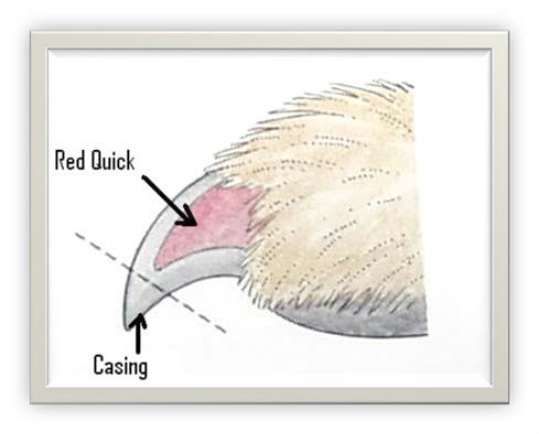Nail care
Nail care

Nail trimming should be done weekly on a pup. Many people are afraid to do this job, and there is no reason to be fearful. If you can cut your own toe nails with a nail clipper, and do the childrens' nails, then surely you can do a puppy's feet!After all, you are bigger and heavier than the puppy! Our puppies have their nails cut weekly here beginning when they are 3 days old. Tools you need for this job are nail clippers - either a "plier type" or a "guillotine" type and a small bottle of a product called Kwik Stop, or Quik Klot.These are powders than you can dip a bleeding nail into if you do cut too much and they will stop the bleeding. Here's a little information about the nail of a dog. The nail is quite thick and grows with a noticeable curve as it gets longer because of lack of trimming.If left unattended, they can grow like talons on a bird of prey.There are generally 4 nails on each foot PLUS an extra nail on the inside of each "ankle" called a 'DewClaw'. They are sort of like our thumbs, except their function is perhaps for a ripping action in a dog fight. Dewclaws can cause a number of problems and do require regular inspection if your dog has them.They get snagged on bushes and other objects - even carpeting - that their legs come in contact with, so you must check immediately if there is bleeding or the dog is licking at the leg or showing pain in the area. Not all dogs are born with DewClaws.If left untrimmed, they will grow in a circle and dig right back into the dogs' leg, which causes extreme pain, and then a high Veterinary bill to anaesthetize the dog to remove the claw surgically. Inside each nail is a blood vessel which behaves in a peculiar way.The blood vessel grows in length at the same time as the nail, so that if you do forget to cut the nails on a regular basis, the blood vessel will be right at the end of the nail and then you CAN'T cut the nail without hurting the dog and having a great deal of bleeding. Now you see the advantage of regular nail care for the puppy - you'll save a lot of money at the Veterinarian's, undoing damage caused by your neglect! Do the nails while he is lying on his side on the table after the brushing.Talk quietly to him as you do all the nails, one foot after the other. The hind feet are ticklish, so he may jerk the hind feet from time to time.Having a second person with you to help control a wiggly puppy is very helpful, and makes the job go more quickly. If you accidentally make the nail bleed DON'T PANIC!The dog panics if you DO - so, if a little blood appears because you cut off too much, STAY CALM, DIP THE NAIL IN THE KWIK STOP, WHICH YOU HAD READY AHEAD OF TIME IN THE LID OF THE CONTAINER,AND KEEP TRIMMING THE REST OF THE NAILS AS IF NOTHING HAS HAPPENED, AND IT IS THE MOST NATURAL THING IN THE WORLD. When he is older, you can trim them every 3-4 weeks, but puppies grow so rapidly that the nails need to be done weekly. It is painful for a dog to walk on long nails, and if they become too long, he will rock back to walk on his "heels" or lower hock joint, to relieve the pressure on the nail beds. Those of us who play a piano, or type, know that we either keep our nails short or develop an unnatural finger position when doing these things, but a dog is on his feet 16 hours a day, so good foot care is very important. This is a good time to check between the pads for excess hair, (which should be cut out with scissors,) for little pebbles or sticks, weeds, wads of sap, or the kids' chewing gum mixed in with the hair. Remove all this debris to avoid painful walking for the dog. Dogs also get cracked pads as well as calluses.Lanolin or Vitamin E oil, rubbed into the cracked pads will help to soften the dryness and heal the cracks.Hoofmaker for horses is a great product for sore, dry, cracked pads.
